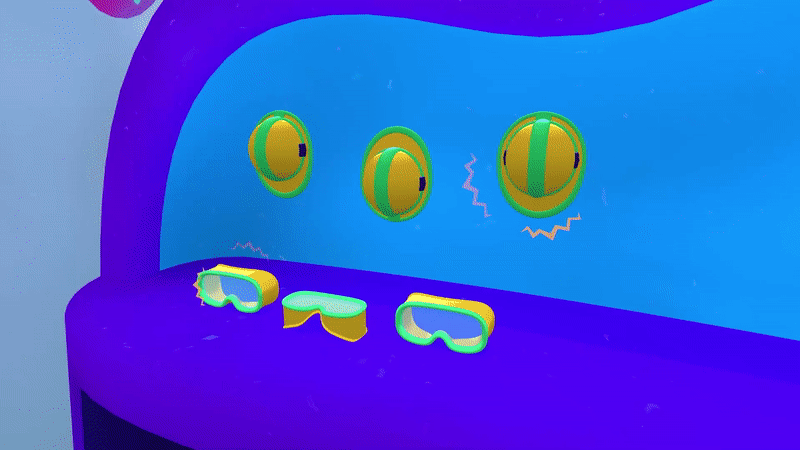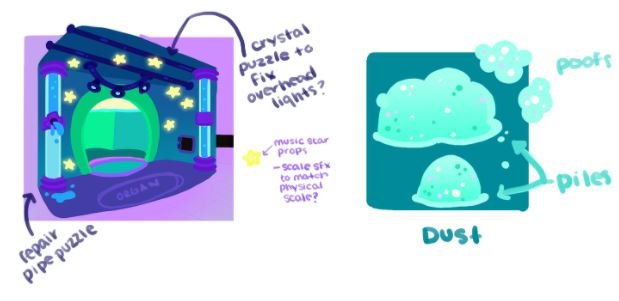
The Power is YOURS
Power Interactions in Cosmonious High
Welcome to our third blog investigating our Interaction is Everything pillar! Buckle up: it’s powers all the way down!
Power to Ya
We prototyped dozens of superpowers early on, looking for patterns around what felt best in game.
Some of our most bizarre prototypes included:
The ability to teleport into any object and get a procedural scene dedicated to that object, including a window out into the larger world from that object’s point of view.
Shooting lightning bolts straight out of your hands and electrifying objects and characters alike (we even had a whole energy system and machines that needed to be ‘charged’).
Controlling a swarm of mechanical wasps, because why not I guess.
While the team got super excited about these funky experiments, accessibility is at the core of what we do, and teaching people how to control a swarm of wasps proved difficult. We needed clearer ties to the real world, or at least super-powers that folks were more familiar with.
Evolution in Iteration
Some of our bizarre ideas – like this sticky-glob power – wound up manifesting as unique types of fluid.
The Ur-Stickium
What felt weird and sometimes claustrophobic as a power felt fantastic as a fluid. That electricity power was cut, but we kept the Coffeen fluid, which also gives everything little jolts of force. How’s that for a buzz?
At one point we even asked ourselves: “is everything just a fluid”? Could fire power just be magma fluid? Could ice power be slush fluid? It was tempting, but we felt everything-is-fluid overly limited the other types of gameplay we knew we wanted (let us know if you figure out how to fluid-ify telekinesis!).
Speaking of telekinesis. When we were leaning into elemental theming, we prototyped a variety of different earth-moving powers.
Our world meshes couldn’t handle that level of flexibility, but we still loved how powerful it felt to lift, toss, and throw things from a distance. You guessed it. One of our most grounded prototypes became the foundation for the archetypal mental power: telekinesis!
“With telekinesis being common in many sci-fi and fantasy worlds, we went through quite a few prototypes before we found something that felt both familiar and like a natural extension of your own body.”
- Peter Galbraith, Accessibility Engineer
We had a few instances like that–where we completely changed the theme of a power while maintaining the underlying mechanics. Our black hole power, which could suck everything in and crush it into a new object, divided up into two features: the wind power, which could swirl things around, and the planetizer in Astralgebra, which could turn anything into a planet.
Design Defrag
While some things diverged, others converged. We cut one power just two months before our content complete milestone.
RIP Plant Power <3
Don’t worry. It was a good thing.
The idea of ‘design defrag’ is that mechanical overlap is usually a sign of inelegant systems. With the plant power, you could grow plants by pointing at any surface, grabbing, and pulling. But…players also expected plants to grow when they watered grass and pots with their fluid power. It just made sense. When we removed the plant power, we didn’t actually lose any of the core functionality of growing plant platforms or restoring pots, a clear sign that the power had to go.
That’s a Handful
In the end, we settled on eight powers, each one obtained from a different challenge in the school.
Compared to our initial wild exploration, this felt like a simple set, but it’s deceptive.
Several of these powers have variations. You can dip your fluid hand in any liquid to change what it shoots out. In our art class, Visualetics, this means you can paint with your powers.
You can also close your hand to charge up your fire, fluid, or ice power and release a powerful elemental orb. Or you can switch your wind power between swirling suction and blowing gusts. If you’re quick enough, you can even combine them both and capture the power orbs with your wind vortex.
It turns out, even if we try to limit the complexity, Owlchemy’s systemic designs have a way of generating combinatory chaos all their own.
Powers In Practice
Accessibility means we couldn’t have gameplay for all of those complex combinations, but we did want gameplay focused on different styles of power usage.
Throughout the school, you’ll find constant little broken elements for your powers to repair, clean, and otherwise tidy up. Super casual! You’ll also come across Bleb Mazes, which were designed to showcase some of the more cerebral aspects of powers and power combinations.
Right in the middle are the extra credit pedestals around the school, which encourage creative use of objects, powers, and school stations.
Whatever power you like best, and however you want to use it, there’s a place for you.
If you’re interested in seeing more powers in action, check out our new gameplay trailer:
Next time we see you, the game will have launched, and we’ll do some technical deep dives on our most innovative features.












